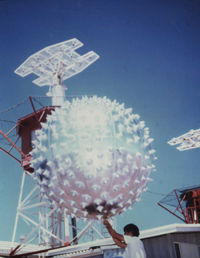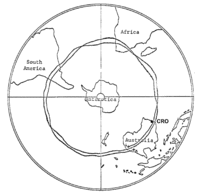Q6 Research Activity
Back to
Contents |
NASA’s space research was never merely about manned space flight. Its policy had always been to offer the use of its network facilities for scientific research by other agencies. But apart from a very instructional series of WRE High Altitude Density (HAD) experiments in 1965 it was not until the end of 1970 that potential research uses for the Carnarvon FPQ-6 Radar emerged.
Jimspheres
The Jimsphere, named for its inventor Dr James Scoggins, was developed to determine whether the vertical wind gradients at launch sites were likely to endanger rocket launches; particularly the giant Saturn launch vehicles for the Apollo missions.
The 2-m diameter radar-reflective Jimsphere balloons were covered with small conical spikes of the same material and looking like an ancient sea-mine. A smooth balloon zigzags or spirals as it ascends and is prone to random horizontal motions which are not a true indication of wind shear patterns. The spiked surface of the Jimsphere reduces lift and increases drag to prevent zigzagging, however it still allows the balloon to respond quickly to changes in wind speed and direction. [1]
Jimspheres were released regularly from Carnarvon between 1970 and 1972 to investigate windshear in the lower atmosphere. FPQ-6 tracked them to a height of about 15 Km. Jimspheres are still used to this present day for meteorological investigations.
The Search for Water Vapour in Space
Probably the most unusual use of FPQ-6 was during 1971 by a US Naval Research Laboratory (NRL) team looking for astronomical sources of water vapour (HO ions). The team jury-rigged a 22 GHz receiver front-end in the FPQ-6 dish and after testing with a known source in the lower northern hemisphere scanned likely sources in the southern hemisphere and found several: Small Magellenic Cloud, Large Magellenic Cloud, 30 Doradus, Car Nebula [E], Car Nebula [OH], etc. [2]
As part of the investigation the team also measured the aperture efficiency of the antenna at 22 GHz to be 0.35 ±0.05 and the main beamwidth to be 6 mins of arc with an estimated overall pointing accuracy of ±1 min of arc. This says a lot for the mechanical precision of the antenna, designed as it was for C band - 5.5GHz.
Territorial Habits of Wedged-tail Eagles
Wedged-tail Eagles were a familiar sight to the FPQ-6 team. A weather balloon carrying a small aluminium sphere was often released for tracking performance tests. Whenever the balloon strayed into eagle territory it was attacked and deflated. The FPQ-6 team was delighted when in 1971 the CSIRO asked for FPQ-6 participation in a study of the territorial habits of their ‘enemy’.
Some preparation for the eagle trials was necessary to see whether FPQ-6 could acquire and track the small waistcoat to be worn by a captured eagle. Dave Gardiner wrote a small computer program to azimuth sweep the antenna to and fro across the Carnarvon fascine. He used “… a Tectonics scope in XY mode with the "A" scope sweep (range) on the Y-axis of the oscilloscope and the X-axis driven by a digital to analogue converter derived from the antenna azimuth angle. The "A" scope video … fed to the Z input on the back of the oscilloscope … controlled the beam intensity … [giving] … a PPI [Plan Position Indicator] display of sorts … not as good as a circular PPI … [because of] … distortion in the display but all … the Fascine buildings and the fishing boats out to sea were displayed.” [3] FPQ-6 was able to pinpoint the waistcoat carried by a small dinghy on top of a wooden pole as it patrolled the fascine.
A nesting pair of eagles, just to the south on Calagiddy Station, was trapped and each fitted with blue metallic waistcoats to reflect radar signals despite FPQ-6 suggestions that this was unnecessary as they could receive echoes from ‘naked’ eagles. It seemed the eagles knew that as well, ripping off the waistcoats as soon as they were released from captivity. [4] Immediately the first eagle was released and ‘acquired’ by the radar, an enthusiastic FPQ-6 tracker grabbed his headset to call Ops reporting, “Q6 confirms positive track of wedge-tailed eagle.” Without losing a beat, one of the Ops team replied, “Roger, Q6. State gender of bird!”
The CSIRO researcher was saved the huge effort of hand-recording azimuth, elevation and range data for later analysis when one of the FPQ-6 crew modified a balloon tracking computer program to provide a plot-board printout scaled to a map of the area. [5] The territory of this pair of eagles was about 13Km by 13Km and up to 1.8Km high. [6]
The CSIRO was delighted with the results and the support received.
TWERLE ‘orbiting’ balloons
TWERLE (Tropical Wind Energy Conversion & Reference Level) Instrumented Platforms weighing up to 200 Kg were carried aloft by a very large balloon. Platform data was collected by the Nimbus-6 satellite while ground radars tracked balloon positions. During 1972, thirty-one investigators representing seven countries launched over 700 platforms.
In 1973 NASA launched the first two TWERLE platforms to orbit the Earth from Oakley Airfield, Queensland They were specially designed to orbit at a constant density altitude and moved in an easterly direction. FPQ-6 provided critical daily support in the last stages of each orbit. The first launch, Project Boomerang, circled the southern latitudes twice in about 36 days at 24 Km high before being brought down about 16Km from the launch point – the second balloon completed three orbits. [7]
Nimbus-6 randomly accessed signals from up to 20 platforms simultaneously, and proved to be ideal for locating small aircraft and boats for 'search and rescue' purposes. The method was adopted for the international 'Search And Rescue Satellite' (SARSAT) network.
References
[1] Wind Monitor, <www.sti.nasa.gov/tto/spinoff1996/48.html >, 16 February 2006
[2] NAA: PP538/2, Box 24; The Astrophysical Journal, 167: L93-L96, 1 August 1971
[3] Gardiner, D., private communication to PD, 11 February 2007
[4] Hocking, R., private communication to PD, 03 February 2005
[5] Green, A., private communication to PD, 11 April 2005
[6] NAA: PP538, S1, B71, StaDir Memorandum to APB, 1 July 1971
[7] NASA News Release No: 73-48; ‘NASA orbits first instrumented balloon’, 20 March 1973


